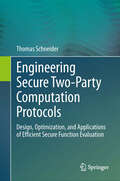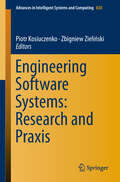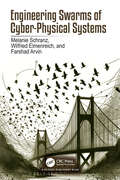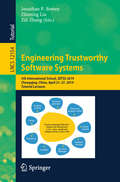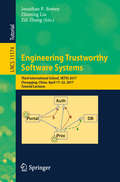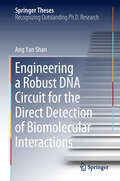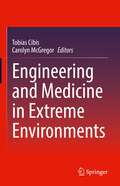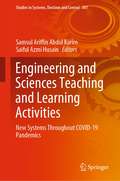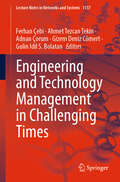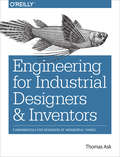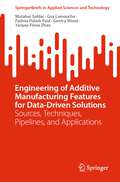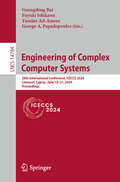- Table View
- List View
Engineering Secure Two-Party Computation Protocols
by Thomas SchneiderSecure two-party computation, called secure function evaluation (SFE), enables two mutually mistrusting parties, the client and server, to evaluate an arbitrary function on their respective private inputs while revealing nothing but the result. Originally the technique was considered to be too inefficient for practical privacy-preserving applications, but in recent years rapid speed-up in computers and communication networks, algorithmic improvements, automatic generation, and optimizations have enabled their application in many scenarios. The author offers an extensive overview of the most practical and efficient modern techniques used in the design and implementation of secure computation and related protocols. After an introduction that sets secure computation in its larger context of other privacy-enhancing technologies such as secure channels and trusted computing, he covers the basics of practically efficient secure function evaluation, circuit optimizations and constructions, hardware-assisted garbled circuit protocols, and the modular design of efficient SFE protocols. The goal of the author's research is to use algorithm engineering methods to engineer efficient secure protocols, both as a generic tool and for solving practical applications, and he achieves an excellent balance between the theory and applicability. The book is essential for researchers, students and practitioners in the area of applied cryptography and information security who aim to construct practical cryptographic protocols for privacy-preserving real-world applications.
Engineering Software Systems: Research and Praxis (Advances In Intelligent Systems and Computing #830)
by Piotr Kosiuczenko Zbigniew ZielińskiThis book highlights a range of new approaches and concepts in the field of software engineering. Based on systematic methods, graphical and formal models, the approaches are designed for solving practical problems encountered in actual software development. The book is divided into 13 chapters, which address core aspects such as security, performance and quality measurement. Chiefly intended to stimulate new research by presenting real problems faced by the industry, and to facilitate software development by applying precisely defined, validated and efficient models and methods, the book offers a valuable guide – for researchers and industry practitioners at small, medium and large companies alike.
Engineering Software for Accessibility
by Microsoft Corporation<div xmlns="http://www.w3.org/1999/xhtml"><p>Get Microsoft design guidelines for developing accessible Web sites and software. By mapping out your accessible tree and planning for implementation at the specification level, you\u2019ll learn to create products that work with assistive technologies.</p></div>
Engineering Software for Modern Challenges: First International Conference, ESMoC 2021, Johor, Malaysia, October 20–21, 2021, Revised Selected Papers (Communications in Computer and Information Science #1615)
by Imran Sarwar Bajwa Dayang Norhayati A. Jawawi Rafaqut KazmiThis volume constitutes selected papers presented at the First International Conference on Engineering Software for Modern Challenges, ESMoC 2021, held in Johor, Malaysia, in October 20-21, 2021.The 17 papers presented were thoroughly reviewed and selected from the 167 submissions. They are organized in the topical sections on software engineering; intelligent systems; software quality.
Engineering Swarms of Cyber-Physical Systems
by Wilfried Elmenreich Farshad Arvin Melanie SchranzEngineering Swarms for Cyber-Physical Systems covers the whole design cycle for applying swarm intelligence in Cyber-Physical Systems (CPS) and guides readers through modeling, design, simulation, and final deployment of swarm systems. The book provides a one-stop-shop covering all relevant aspects for engineering swarm systems. Following a concise introduction part on swarm intelligence and the potential of swarm systems, the book explains modeling methods for swarm systems embodied in the interplay of physical swarm agents. Examples from several domains including robotics, manufacturing, and search and rescue applications are given. In addition, swarm robotics is further covered by an analysis of available platforms, computation models and applications. It also treats design methods for cyber-physical swarm applications including swarm modeling approaches for CPSs and classical implementations of behaviors as well as approaches based on machine-learning. A chapter on simulation covers simulation requirements and addresses the dichotomy between abstract and detailed physical simulation models. A special feature of the chapters is the hands-on character by providing programming examples with the different engineering aspects whenever possible, thus allowing for fast translation of concepts to actual implementation. Overall, the book is meant to give a creative researcher or engineer the inspiration, theoretical background, and practical knowledge to build swarm systems of CPSs. It also serves as a text for students in science and engineering.
Engineering Trustworthy Software Systems
by Jonathan P. Bowen Zhiming Liu Zili ZhangThis volume contains a record of some of the lectures and seminars delivered at the Second International School on Engineering Trustworthy Software Systems (SETSS 2016), held in March/April 2016 at Southwest University in Chongqing, China. The six contributions included in this volume provide an overview of leading-edge research in methods and tools for use in computer system engineering. They have been distilled from six courses and two seminars on topics such as: modelling and verification in event-B; parallel programming today; runtime verification; Java in the safety-critical domain; semantics of reactive systems; parameterized unit testing; formal reasoning about infinite data values; and Alan Turing and his remarkable achievements. The material is useful for postgraduate students, researchers, academics, and industrial engineers, who are interested in the theory and practice of methods and tools for the design and programming of trustworthy software systems.
Engineering Trustworthy Software Systems
by Zhiming Liu Zili ZhangThis volume contains the lecture notes of the five coursesand one seminar given at the School on Engineering Trustworthy Software Systems(SETSS 2014), held in September 2014 at Southwest University in Chongqing,China. The material is useful for postgraduate students,researchers, academics and industrial engineers who are interested in thetheory and practice of methods and tools for the design and programming oftrustworthy software systems. The common themes of the courses include thedesign and use of theories, techniques and tools for software specification andmodeling, analysis and verification. The courses cover sequential programming,component- and object software, hybrid systems and cyber-physical systems withchallenges of termination, security, safety, security, fault-tolerance andreal-time requirements. The techniques include model checking, correctness byconstruction through refinement and model transformations, synthesis andcomputer algebra.
Engineering Trustworthy Software Systems: 4th International School, SETSS 2018, Chongqing, China, April 7–12, 2018, Tutorial Lectures (Lecture Notes in Computer Science #11430)
by Jonathan P. Bowen Zhiming Liu Zili ZhangThis volume contains lectures on leading-edge research in methods and tools for use in computer system engineering; at the 4th International School on Engineering Trustworthy Software Systems, SETSS 2018, held in April 2018 at Southwest University in Chongqing, China.The five chapters in this volume provide an overview of research in the frontier of theories, methods, and tools for software modelling, design, and verification. The topics covered in these chapter include Software Verification with Whiley, Learning Büchi Automata and Its Applications, Security in IoT Applications, Programming in Z3, and The Impact of Alan Turing: Formal Methods and Beyond. The volume provides a useful resource for postgraduate students, researchers, academics, and engineers in industry, who are interested in theory, methods, and tools for the development of trustworthy software.
Engineering Trustworthy Software Systems: 4th International School, SETSS 2018, Chongqing, China, April 7–12, 2018, Tutorial Lectures (Lecture Notes in Computer Science #11430)
by Jonathan P. Bowen Zhiming Liu Zili ZhangThis volume contains lectures on leading-edge research in methods and tools for use in computer system engineering; at the 4th International School on Engineering Trustworthy Software Systems, SETSS 2018, held in April 2018 at Southwest University in Chongqing, China.The five chapters in this volume provide an overview of research in the frontier of theories, methods, and tools for software modelling, design, and verification. The topics covered in these chapter include Software Verification with Whiley, Learning Büchi Automata and Its Applications, Security in IoT Applications, Programming in Z3, and The Impact of Alan Turing: Formal Methods and Beyond. The volume provides a useful resource for postgraduate students, researchers, academics, and engineers in industry, who are interested in theory, methods, and tools for the development of trustworthy software.
Engineering Trustworthy Software Systems: 5th International School, SETSS 2019, Chongqing, China, April 21–27, 2019, Tutorial Lectures (Lecture Notes in Computer Science #12154)
by Jonathan P. Bowen Zhiming Liu Zili ZhangThis book constitutes the refereed proceedings of the 5th International School on Engineering Trustworthy Software Systems, SETSS 2019, held in Chongqing, China, in April 2019.The five chapters in this volume provide lectures on leading-edge research in methods and tools for use in computer system engineering. The topics covered in these chapter include Seamless Model-based System Development: Foundations; From Bounded Reachability Analysis of Linear Hybrid Automata to Verification of Industrial CPS and IoT; Weakest Preexpectation Semantics for Bayesian Inference: Conditioning, Continuous Distributions and Divergence; K – A Semantic Framework for Programming Languages and Formal Analysis Tools; and Software Abstractions and Human-Cyber-Physical Systems Architecture Modelling.
Engineering Trustworthy Software Systems: 6th International School, SETSS 2024, Chongqing, China, April 14–21, 2024, Tutorial Lectures (Lecture Notes in Computer Science #15584)
by Jonathan P. Bowen Zhiming Liu Cláudio GomesThis book PSE 15584 constitutes the refereed proceedings of the 6th International School on Engineering Trustworthy Software Systems, SETSS 2024, held in Chongqing, China, in April 14-21, 2024. The 5 full papers and 2 short papers were carefully reviewed and selected from 7 submissions. The proceedings focuses on -Preparatory Course: Introduction to Mathematical Logic and Logic of Programming; -Introduction to Digital Twins -Theories of Contracts and Their Applications -From Automata Models to Validated BCI-Based Cooperative Control On the Viability of Rigorous Approaches to Human-Cyber-Physical Systems of Systems; What Came First, Math or Computing? -What Came First, Math or Computing? -Software Engineering for Explainable AI -Distribution Testing: The New Frontier for Formal Methods
Engineering Trustworthy Software Systems: First International School, SETSS 2014, Chongqing, China, September 8-13, 2014. Tutorial Lectures (Lecture Notes in Computer Science #9506)
by Zhiming Liu Zili ZhangThis volume contains the lecture notes of the five courses and one seminar given at the School on Engineering Trustworthy Software Systems (SETSS 2014), held in September 2014 at Southwest University in Chongqing, China. The material is useful for postgraduate students, researchers, academics and industrial engineers who are interested in the theory and practice of methods and tools for the design and programming of trustworthy software systems. The common themes of the courses include the design and use of theories, techniques and tools for software specification and modeling, analysis and verification. The courses cover sequential programming, component- and object software, hybrid systems and cyber-physical systems with challenges of termination, security, safety, security, fault-tolerance and real-time requirements. The techniques include model checking, correctness by construction through refinement and model transformations, synthesis and computer algebra.
Engineering Trustworthy Software Systems: Second International School, SETSS 2016, Chongqing, China, March 28 - April 2, 2016, Tutorial Lectures (Lecture Notes in Computer Science #10215)
by Jonathan P. Bowen Zhiming Liu Zili ZhangThis volume contains a record of some of the lectures and seminars delivered at the Second International School on Engineering Trustworthy Software Systems (SETSS 2016), held in March/April 2016 at Southwest University in Chongqing, China.The six contributions included in this volume provide an overview of leading-edge research in methods and tools for use in computer system engineering. They have been distilled from six courses and two seminars on topics such as: modelling and verification in event-B; parallel programming today; runtime verification; Java in the safety-critical domain; semantics of reactive systems; parameterized unit testing; formal reasoning about infinite data values; and Alan Turing and his remarkable achievements. The material is useful for postgraduate students, researchers, academics, and industrial engineers, who are interested in the theory and practice of methods and tools for the design and programming of trustworthy software systems.
Engineering Trustworthy Software Systems: Third International School, SETSS 2017, Chongqing, China, April 17–22, 2017, Tutorial Lectures (Lecture Notes in Computer Science #11174)
by Jonathan P. Bowen Zhiming Liu Zili ZhangThis volume contains a record of some of the lectures and seminars delivered at the Third International School on Engineering Trustworthy Software Systems (SETSS 2017), held in April 2017 at Southwest University in Chongqing, China. The six contributions included in this volume provide an overview of leading-edge research in methods and tools for use in computer system engineering. They have been distilled from six original courses delivered at the school on topics such as: rely/guarantee thinking; Hoare-style specification and verification of object-oriented programs with JML; logic, specification, verification, and interactive proof; software model checking with Automizer; writing programs and proofs; engineering self-adaptive software-intensive systems; and with an additional contribution on the challenges for formal semantic description. The material is useful for postgraduate students, researchers, academics, and industrial engineers, who are interested in the theory and practice of methods and tools for the design and programming of trustworthy software systems.
Engineering a Robust DNA Circuit for the Direct Detection of Biomolecular Interactions (Springer Theses)
by Ang Yan ShanThis book provides essential insights into designing a localized DNA circuit to promote the rate of desired hybridization reactions over undesired leak reactions in the bulk solution. The area of dynamic DNA nanotechnology, or DNA circuits, holds great promise as a highly programmable toolbox that can be used in various applications, including molecular computing and biomolecular detection. However, a key bottleneck is the recurring issue of circuit leakage. The assembly of the localized circuit is dynamically driven by the recognition of biomolecules – a different approach from most methods, which are based on a static DNA origami assembly. The design guidelines for individual reaction modules presented here, which focus on minimizing circuit leakage, are established through NUPACK simulation and tested experimentally – which will be useful for researchers interested in adapting the concepts for other contexts. In the closing section, the design concepts are successfully applied to the biomolecular sensing of a broad range of targets including the single nucleotide mutations, proteins, and cell surface receptors.
Engineering and Management of IT-based Service Systems
by Jorge Marx Gómez Manuel Mora Leonardo Garrido Francisco Cervantes PérezIntelligent Decision-Making Support Systems (i-DMSS) are specialized IT-based systems that support some or several phases of the individual, team, organizational or inter-organizational decision making process by deploying some or several intelligent mechanisms. This book pursues the following academic aims: (i) generate a compendium of quality theoretical and applied contributions in Intelligent Decision-Making Support Systems (i-DMSS) for engineering and management IT-based service systems (ITSS); (ii) diffuse scarce knowledge about foundations, architectures and effective and efficient methods and strategies for successfully planning, designing, building, operating, and evaluating i-DMSS for ITSS, and (iii) create an awareness of, and a bridge between ITSS and i-DMSS academicians and practitioners in the current complex and dynamic engineering and management ITSS organizational. The book presents a collection of 11 chapters referring to relevant topics for both IT service systems and i-DMSS including: problems of selection of IT service providers, optimization of supply chain systems, IT governance decisions, clinical decision support, dynamic user-interface adaptation, re-engineering of processes, and generic decision problems. Advanced IT technologies used in some chapters are: fuzzy multi-criteria mechanisms, semantic processing, data mining processing, and rough sets. Other chapters report traditional DSS mechanisms but used or suggested to be used in innovative mode for IT service engineering and management tasks.
Engineering and Medicine in Extreme Environments
by Tobias Cibis Carolyn McGregor AmThis book brings together in-depth information on a wide array of bio-engineering topics and their application to enhance human health, performance, comfort, and survival in extreme environments. Contributions from biomedical engineering, information systems, medicine and physiology, and medical engineering are presented in relation to a broad range of harsh and extreme environmental scenarios, including underwater, terrestrial (both natural and man-made), and space travel. Physicians, engineers, and scientists, as well as researchers and graduate students, will find the book to be an invaluable resource.Details effects of extreme environments on human physiology;Presents human-environment interaction in different scenarios;Overview of engineering challenges and problems in extreme environments.
Engineering and Sciences Teaching and Learning Activities: New Systems Throughout COVID-19 Pandemics (Studies in Systems, Decision and Control #381)
by Samsul Ariffin Abdul Karim Saiful Azmi HusainThis book comes from genuine research from various universities in Asia, such as in South East Asia and India. Since COVID-19 pandemic is spreading all over the world, most schools and institutions of higher learning have opted online-based learning for their teaching and learning (T&L) activities. Previously, the common practices in T&L are face to face (F2F). Therefore, online T&L is a new normal not just for the students but also for the instructors as well as the parents. In this book, different online teaching methods via technology-supported teaching have been implemented, and at the end of the lesson, based on the feedback from students on these online technology-supported teaching tools, most educators found that there are positive responses from majority of students, in terms of their learning, attitudes, thinking and decision-making process, apart from the challenges faced by the students in the beginning, with regards to the new approaches and methodology used by their teachers during online teaching. There are eight contributed chapters in this book covering secondary school-level curriculum up to higher institutional-level curriculum that forming a new system of T&L for post-COVID-19 pandemic. The topics under consideration include active learning (AL) and cooperative learning (CL) for T&L, task-based instruction (TBI), transition students’ adaptability to post-COVID-19, creative and innovative teaching methods for secondary school-level mathematics, project-based learning (PPBL) for geophysics and impact of Socratic method and SOLO taxonomy. This book is suitable for postgraduate students, teachers, instructor, educational researchers, as well as policy makers in education and other scientists who are dedicated in teaching and educate students.
Engineering and Technology Management in Challenging Times (Lecture Notes in Networks and Systems #1137)
by Ferhan Çebi Ahmet Tezcan Tekin Adnan Çorum Gizem Deniz Cömert Gulin Idil S. BolatanThe book is an important resource to effectively combat these challenges and guide businesses and institutions toward success. Today's world is experiencing a period in which, on the one hand, technical advances, innovations, and changes are developing at an increasingly rapid pace, and on the other hand, uncertain global challenges are emerging. Managers in the field of engineering and technology must skillfully manage this complexity and uncertainty. Reasons to Consider Reading This Book: · Acquiring advanced methodologies and tools to efficiently oversee engineering and technology projects, especially in highly volatile circumstances. · Gaining valuable insights from industry experts and experienced professionals as they impart their knowledge, expertise, and groundbreaking ideas. · Experiencing practical approaches for learning effective strategies and tangible techniques to improve productivity, maximize resources, and promote creativity. The book helps · Engineers and technologists to be able to find solutions to the problems they encounter with the most up-to-date methods. · Business leaders to be able to have a deep understanding of how to effectively leverage technology to achieve strategic advantage and ensure the resilience of their companies · Students and educators to be able to acquire new knowledge by combining academic knowledge with practical application This book serves as a comprehensive guide that provides a clear path to adaptability, creativity, and achievement in an uncertain global landscape. The book emphasizes “Do not merely endure the difficulties and solve them; improve, shape, and take charge with assurance”.
Engineering and the Mind's Eye
by Eugene S. FergusonIn this insightful and incisive essay, Eugene Ferguson demonstrates that good engineering is as much a matter of intuition and nonverbal thinking as of equations and computation. He argues that a system of engineering education that ignores nonverbal thinking will produce engineers who are dangerously ignorant of the many ways in which the real world differs from the mathematical models constructed in academic minds.
Engineering for Industrial Designers and Inventors: Fundamentals for Designers of Wonderful Things
by Thomas AskIf you have designs for wonderful machines in mind, but aren’t sure how to turn your ideas into real, engineered products that can be manufactured, marketed, and used, this book is for you. Engineering professor and veteran maker Tom Ask helps you integrate mechanical engineering concepts into your creative design process by presenting them in a rigorous but largely nonmathematical format.Through mind stories and images, this book provides you with a firm grounding in material mechanics, thermodynamics, fluid dynamics, and heat transfer. Students, product and mechanical designers, and inventive makers will also explore nontechnical topics such as aesthetics, ethnography, and branding that influence product appeal and user preference.Learn the importance of designing functional products that also appeal to users in subtle waysExplore the role of aesthetics, ethnography, brand management, and material culture in product designDive into traditional mechanical engineering disciplines related to the behavior of solids, liquids, and gasesUnderstand the human factors of design, such as ergonomics, kinesiology, anthropometry, and biomimicryGet an overview of available mechanical systems and components for creating your product
Engineering in Dependability of Computer Systems and Networks: Proceedings of the Fourteenth International Conference on Dependability of Computer Systems DepCoS-RELCOMEX, July 1–5, 2019, Brunów, Poland (Advances in Intelligent Systems and Computing #987)
by Janusz Kacprzyk Wojciech Zamojski Jacek Mazurkiewicz Jarosław Sugier Tomasz WalkowiakThis book presents papers on various problems of dependability in computer systems and networks that were discussed at the 14th DepCoS-RELCOMEX conference, in Brunów, Poland, from 1st to 5th July 2019. Discussing new ideas, research results and developments in the design, implementation, maintenance and analysis of complex computer systems, it is of interest to researchers and practitioners who are dealing with dependability issues in such systems. Dependability analysis came as a response to new challenges in the evaluation of contemporary complex systems, which should be considered as systems of people – with their needs and behaviours –interacting with technical communication channels (such as mobile activities, iCloud, Internet of Everything) and online applications, often operating in hostile environments. The diversity of topics covered, illustrates the variety of methods used in this area, often with the help of the latest results in artificial and computational intelligence.
Engineering of Additive Manufacturing Features for Data-Driven Solutions: Sources, Techniques, Pipelines, and Applications (SpringerBriefs in Applied Sciences and Technology)
by Mutahar Safdar Guy Lamouche Padma Polash Paul Gentry Wood Yaoyao Fiona ZhaoThis book is a comprehensive guide to the latest developments in data-driven additive manufacturing (AM). From data mining and pre-processing to signal processing, computer vision, and more, the book covers all the essential techniques for preparing AM data. Readers willl explore the key physical and synthetic sources of AM data throughout the life cycle of the process and learn about feature engineering techniques, pipelines, and resulting features, as well as their applications at each life cycle phase. With a focus on featurization efforts from reviewed literature, this book offers tabular summaries for major data sources and analyzes feature spaces at the design, process, and structure phases of AM to uncover trends and insights specific to feature engineering techniques. Finally, the book discusses current challenges and future directions, including AI/ML/DL readiness of AM data. Whether you're an expert or newcomer to the field, this book provides a broader summary of the status and future of data-driven AM technology.
Engineering of Complex Computer Systems: 28th International Conference, ICECCS 2024, Limassol, Cyprus, June 19–21, 2024, Proceedings (Lecture Notes in Computer Science #14784)
by Fuyuki Ishikawa George A. Papadopoulos Yamine Ait-Ameur Guangdong BaiThis book constitutes of the proceedings from the 28th International Conference on Engineering of Complex Computer Systems, ICECCS 2024, held in Limassol, Cyprus, during June 19–21, 2024. The 18 full papers and 4 short papers presented here were carefully reviewed and selected from 68 submissions. These papers have been categorized into the following sections: Machine Learning and Complex Systems; Neural Network Verification; A.I. for Software Engineering; Smart Contract; Formal Methods; Security & Program Analysis.
Engineering of Computer-Based Systems: 8th International Conference, ECBS 2023, Västerås, Sweden, October 16–18, 2023, Proceedings (Lecture Notes in Computer Science #14390)
by Tiziana Margaria Jan Kofroň Cristina SeceleanuThis book constitutes the refereed proceedings of the 8th International Conference on Engineering of Computer-Based Systems, ECBS 2023, which was held in Västerås, Sweden, in October 2023. The 11 full papers included in this book were carefully reviewed and selected from 26 submissions and present software, hardware, and communication perspectives of systems engineering through its many facets. The special theme of this year is ”Engineering for Responsible AI“.
